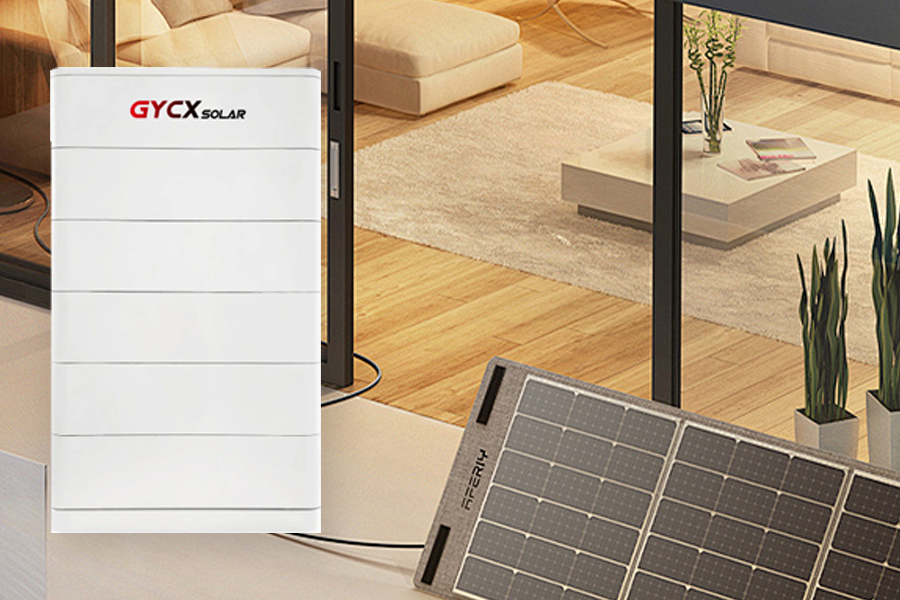
Viime vuosina, Energian varastointiratkaisuille on kasvava kysyntä, jotka tukevat uusiutuvia energialähteitä, kuten aurinko ja tuuli. Pinottujen energian varastointiparistot ovat nousseet lupaavana tekniikkana tämän kysynnän tyydyttämiseksi.
Pinottu akkujärjestelmät antavat useita paristoja virran useita sähkölaitteita samanaikaisesti. Nämä paristot ovat edistyksellinen energiatekniikka, joka voidaan kytkeä rinnakkain tai sarjaan kapasiteetin tai jännitteen lisäämiseksi. Tämä artikkeli vie sinut kattavaan ymmärrykseen pinottavista litiumparistoista, niin että sinulla on uusi ymmärrys!
Litiumparistojen perusteet
Kuinka litiumakku toimii

Työperiaate litiumparistot pääasiassa latauksen siirtoprosessi. Litiumioniakuissa, Kyseessä on kaksi prosessia: lataaminen ja purkaminen:
Latausprosessi: Kun litium -akku ladataan, Akun positiivinen pää tuottaa litiumioneja, jotka sitten siirtyvät elektrolyytin läpi akun negatiiviseen päähän. Negatiivinen elektrodi koostuu yleensä kerroksisesta hiilimateriaalista, jolla on monia mikrohantoja, ja nämä negatiivisen elektrodin saavuttavat litiumioulit upotetaan hiilikerroksen mikrohuokoihin.
Purkausprosessi: Kun akku purkautuu, Negatiivisen elektrodin litiumioulit siirtyvät takaisin positiiviseen elektrodiin elektrolyytin läpi, ja vapauta elektroneja, tuloksena sähkövirta. Tätä virtaa voidaan sitten käyttää useilla laitteilla.
Litiumparistojen luokittelu
Litiumparistot on jaettu pääasiassa kahteen luokkaan: litiummetalliakut ja litiumioni -akut.

Litiummetalliparistot käyttävät litiummetallia tai sen seosta negatiivisena elektrodimateriaalina, kun taas litium-ioni-akut käyttävät litiumseosmetallioksidia positiivisena elektrodimateriaalina ja grafiitina negatiivisena elektrodimateriaalina.
Sen elektrolyytin tilan mukaan, Litium-ion-akut voidaan jakaa myös nestemäisiin litium-ion-akkuihin, Polymeerin litium-ion-akut ja kaikki kiinteät ioni-akut.
Mikä on pinottava litium -akku?
Pinottava litium -akku on energian säilytysjärjestelmä, joka on muodostettu pinoamalla useita akkumoduuleja yhteen. Nämä moduulit on kytketty sarjaan tai rinnakkain akkujärjestelmän kokonaiskapasiteetin ja jännitteen lisäämiseksi. Useiden akkumoduulien käyttäminen tarjoaa myös redundanssin, antaa järjestelmän jatkaa toimintaa, vaikka yksi tai useampi moduuli epäonnistuu.

Pinottavan litiumpariston komponentit
Pinottava litium -akku koostuu useista avainkomponenteista, mukaan lukien:
Akkumoduulit
Nämä ovat yksittäisiä akkukennoja, jotka muodostavat järjestelmän. Jokainen moduuli sisältää yhden tai useamman akkukennon, jotka on kytketty toisiinsa sarjassa tai rinnakkain korkeamman jännitteen tai kapasiteetin tuottamiseksi.
Akun hallintajärjestelmä (BMS)
Tämä on laite, joka tarkkailee ja ohjaa akkujärjestelmän suorituskykyä. BMS vastaa kunkin akkumoduulin lataamisen ja purkamisen tasapainottamisesta, samoin kuin järjestelmän suojaaminen ylikuormitukselta, ylikuumeneminen ja ylikuormitus.
Invertteri
Tämä laite muuntaa akkujärjestelmän tuottaman tasajännitteen vaihtovirtajännitteeksi, jota voidaan käyttää sähkölaitteiden virtaamiseen.
Jäähdytysjärjestelmä
Pinottu energian varastointiparistot aiheuttavat lämpöä käytön aikana, Joten tarvitaan jäähdytysjärjestelmä lämpötilan pitämiseksi turvallisella alueella.

Kuinka pinottava litiumakku toimii?
Laminoitu energian varastointiparistot toimivat varastoimalla sähköenergiaa kemiallisen energian muodossa. Kun akku ladataan, Kemiallinen reaktio akkumoduulissa luo potentiaalieron positiivisten ja negatiivisten päätteiden välillä. Tätä potentiaalieroa ylläpidetään, kunnes akku on purettu, Silloin kemiallinen reaktio kääntyy ja sähkö vapautuu.
Akunhallintajärjestelmällä on tärkeä rooli varmistamisessa, että akkumoduuli ladataan ja vapautetaan tasapainoisella ja ohjattavalla tavalla. Jos yksi tai useampi akkumoduulit lataa tai ylikuormittaa, BMS säätää automaattisesti muiden moduulien varausta ja purkamista tasapainon ylläpitämiseksi.
Pinottavien litiumparistojen edut
Suuri kapasiteetti:
Pinoamalla useita akkumoduuleja, Voit hankkia suuremman energian varastointikapasiteetin vastaamaan korkean energian laitteiden tai pitkäaikaisen käytön vaatimuksia.
Suuren teho:
Pino -suunnittelu mahdollistaa useiden akkumoduulien kytkemisen rinnakkain suuremman tehon tuotannon aikaansaamiseksi, joka sopii skenaarioihin, jotka vaativat hetkellistä suurta voimaa.
Skaalautuvuus
Pinottavat litiumparistot voivat lisätä tai poistaa moduuleja tarvittaessa joustavan järjestelmän laajennuksen ja kapasiteetin säätämisen saavuttamiseksi.
Järjestelmän vakaus
Pinottu muotoilu tarjoaa paremman akun tasapainon ja lämpötilan hallinnan, Kunkin akkumoduulin tasapainotetun suorituskyvyn varmistaminen ja lämpöpisteiden esiintymisen vähentäminen.
Korkea tilan käyttö
Pino -suunnittelu käyttää tehokkaasti tilaa ja vähentää laitteen jalanjälkeä, joka sopii sovellusskenaarioihin, joissa tilaa on rajoitettu.
GYCX-aurinko muistuttaa meitä siitä, että pinottavan akkujärjestelmän suunnittelun ja asentamisen on harkittava moduulien välisen yhteyden vaatimuksia, lämmönhallinta, turvallisuussuojaus ja muut näkökohdat järjestelmän vakauden ja turvallisuuden varmistamiseksi. Siksi, pinottavan litiumakkujärjestelmän valinnassa ja käytössä, tulisi noudattaa asiaankuuluvia eritelmiä ja standardeja, ja hae ammattimainen pinottava litium -akkuvalmistajat tekninen tuki ja neuvoja.
Pinottavien litiumparistojen sovellukset
Sähköajoneuvot: Pinottavia litiumparistoja käytetään laajasti sähköajoneuvojen alalla niiden suuren energian tiheyden ja pitkien käyttöominaisuuksien vuoksi, jotka voivat parantaa merkittävästi sähköajoneuvojen ajoaluetta ja turvallisuutta.
Energian varastointijärjestelmä: Energian varastoinnin alalla, pinottavat litiumparistot, Korkean energian varastointitehokkuudella ja vakaalla suorituskyvyllä, on tullut ihanteellinen valinta ratkaista energian varastointi- ja tasapainon ongelma hajautetuissa energiajärjestelmissä, Auttaa varmistamaan sähköjärjestelmän vakauden ja luotettavuuden.
Sotilaskenttä: Korkean energian tiheyden ja nopean latausominaisuuksien vuoksi, Pinottavilla litiumparistoilla on välttämätön rooli sotilaslaitteissa, kuten viestintälaitteet, Yökyvyn laitteet ja droonit, joiden on tarjottava kestävä ja vakaa voimatuki.
Sähköteollisuus: Sähköteollisuudessa, Pinottavia litiumparistoja käytetään parantamaan sähköverkon vakautta ja luotettavuutta, Yhdistämällä uusiutuvien energialähteiden, kuten tuulen ja aurinkoenergian,, Energian varastoinnin ja tasapainon saavuttamiseksi.
Rautatieyhteys: minäN Rail Transit, Pinottavia litium -akkuja käytetään parantamaan rautatieyhteyden ajoneuvojen energiansäästöä ja ympäristönsuojelua, kuten rautateiden kauttakulkuajoneuvojen virtalähde, perinteisten dieselmoottorien korvaaminen.
Kulutuselektroniikka: Älypuhelimista ja tableteista kannettaviin tietokoneisiin ja kaikenlaisiin puettaviin laitteisiin, Pinottavat litiumparistot tarjoavat kestävän ja vakaan virtalähteen näille laitteille.
Ilmailu-: Ilmailu-, Pinottavat litiumparistot ovat ihanteellisia lentokoneiden apuvoimalle niiden korkean energian tiheyden ja kevyiden ominaisuuksien vuoksi.
Lääketieteelliset laitteet: Pinottavia litiumparistoja käytetään myös laajasti lääketieteellisten laitteiden alalla, kuten B-ultraäänikoneet, elektrokardiogrammikoneet, jne., joiden on tarjottava vakaa voimatuki.
Pinottavissa litiumparistoissa on laaja valikoima sovelluksia, Energian varastoinnista henkilökohtaisiin elektronisiin laitteisiin, osoittaa niiden merkityksen nykyaikaisessa tekniikassa ja teollisuudessa
Pinottavan litiumakarkkimarkkinat näkymät 2024

Pinottava litium -akun markkinoiden koon ennuste
Pinottavien litiumparistojen markkinoiden näkymät sisään 2024 näyttää erittäin kirkkaalta. Globaalin litium -akkuenergian varastointimarkkinoiden koon odotetaan saavuttavan 235 GWH, mikä osoittaa, että litiumparistojen kysyntä kasvaa edelleen. Dollarin mukaan, Sen odotetaan saavuttavan $40 miljardi, ylöspäin 14% Vuotta sitten. Litiumparistojen maailmanlaajuisen kysynnän odotetaan ylläpitävän enemmän kuin enemmän kuin 30%.
Pinottava litium -akkutekniikka kehittyy
Litium -akkuprosessin energiankulutustrendin odotetaan säilyttävän tasaisen laskun tulevina vuosina, joka tekee tuotannosta ympäristöystävällisemmän ja mahdollisesti vähentää tuotantokustannuksia. Tämä tarkoittaa myös sitä, että tekniikan paranemisella ja tuotantomenetelmien parantamisella, Tulevat litiumakkutuotteet ovat yhä tehokkaampia.
Tulevaisuuden kehityssuuntaus
Raportin mukaan, Globaalit kannettavat akkumarkkinat ovat arvoisia $10.8 miljardi 2020 ja sen odotetaan kasvavan $27.5 miljardi 2030, CAGR: llä 10.4% -sta 2021 to 2030. Pinottavat akut ovat kannettavan akkuteollisuuden ytimessä, Ja sellaisenaan, Niiden markkinoiden odotetaan kasvavan räjähdysmäisesti.
Kiinnostus vaihtoehtoisiin energiateknologioihin, kuten aurinkoenergian ja tuulivoiman, on toinen tärkeä tekijä pinottujen akkujen kehittämisessä. Uusiutuvat energialähteet tuottavat ajoittaista sähköä, joka voidaan tallentaa pinottujen akkujen avulla. Lisäksi, Älykkäiden ruudukkojen ja mikroverkojen suosion kasvaessa, Pinottujen paristojen odotetaan olevan tärkeä rooli kestävän energian integroinnissa verkkoon. Ne voivat myös tarjota varmuuskopiovoimaa ruudukkovirheiden tai sähkökatkojen tapauksessa.
Johtopäätös
Tiivistettynä, Vaikka paristoja on mahdollista pinota varastointia varten, Useita tekijöitä ja varotoimenpiteitä on otettava huomioon. On tärkeää arvioida akun tyyppi ja varaustila ja toteuttaa tarvittavat turvatoimenpiteet.
Jos sinulla on pinottava litium -akku tarpeisiin, voit ottaa meihin yhteyttä klo GYCX aurinko, Yhden luukun teollisuusasiantuntija, joka voi auttaa sinua yhdistämään akun säilytysjärjestelmän järjestelmän kanssa. Valitse paras aurinkoratkaisu kotiisi tai yrityksellesi.
